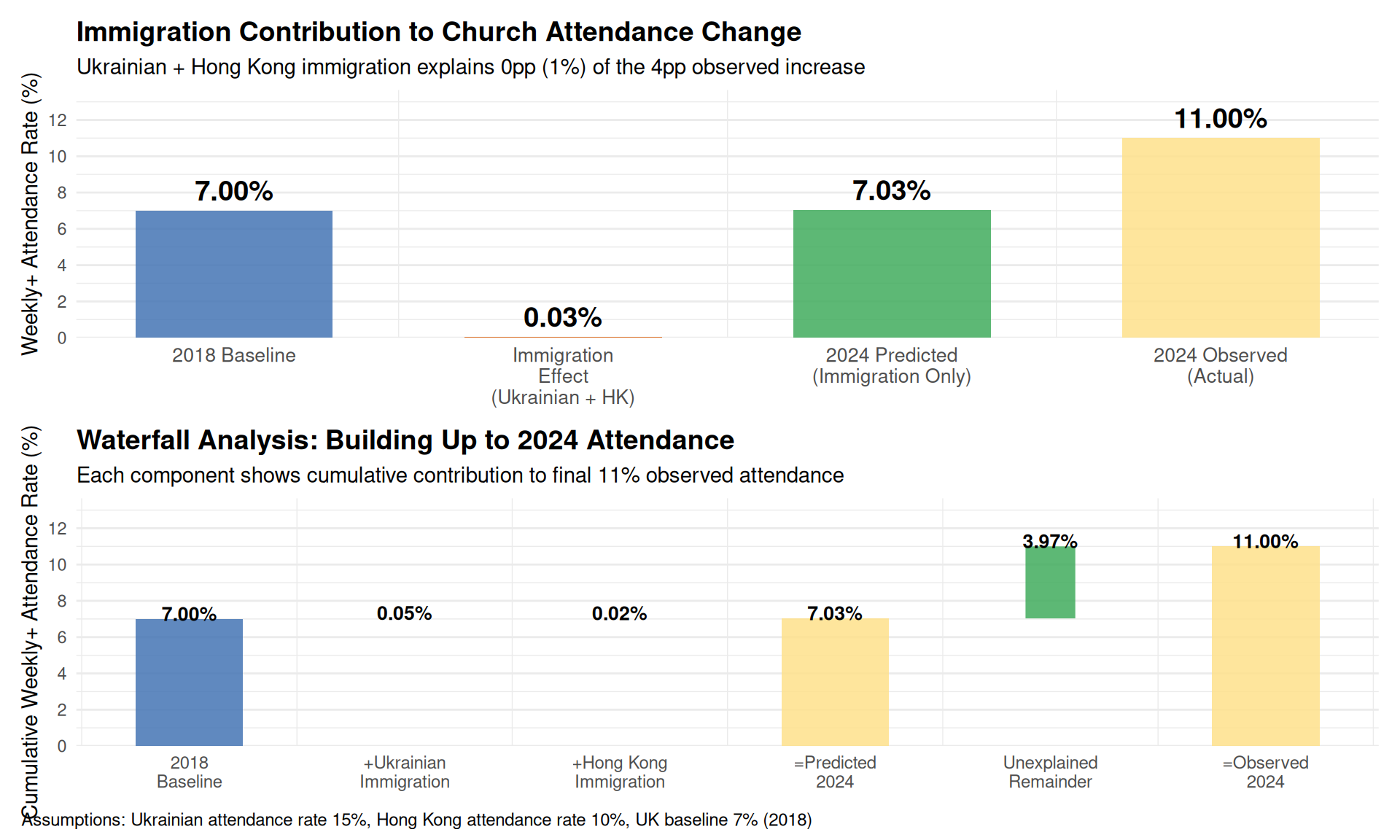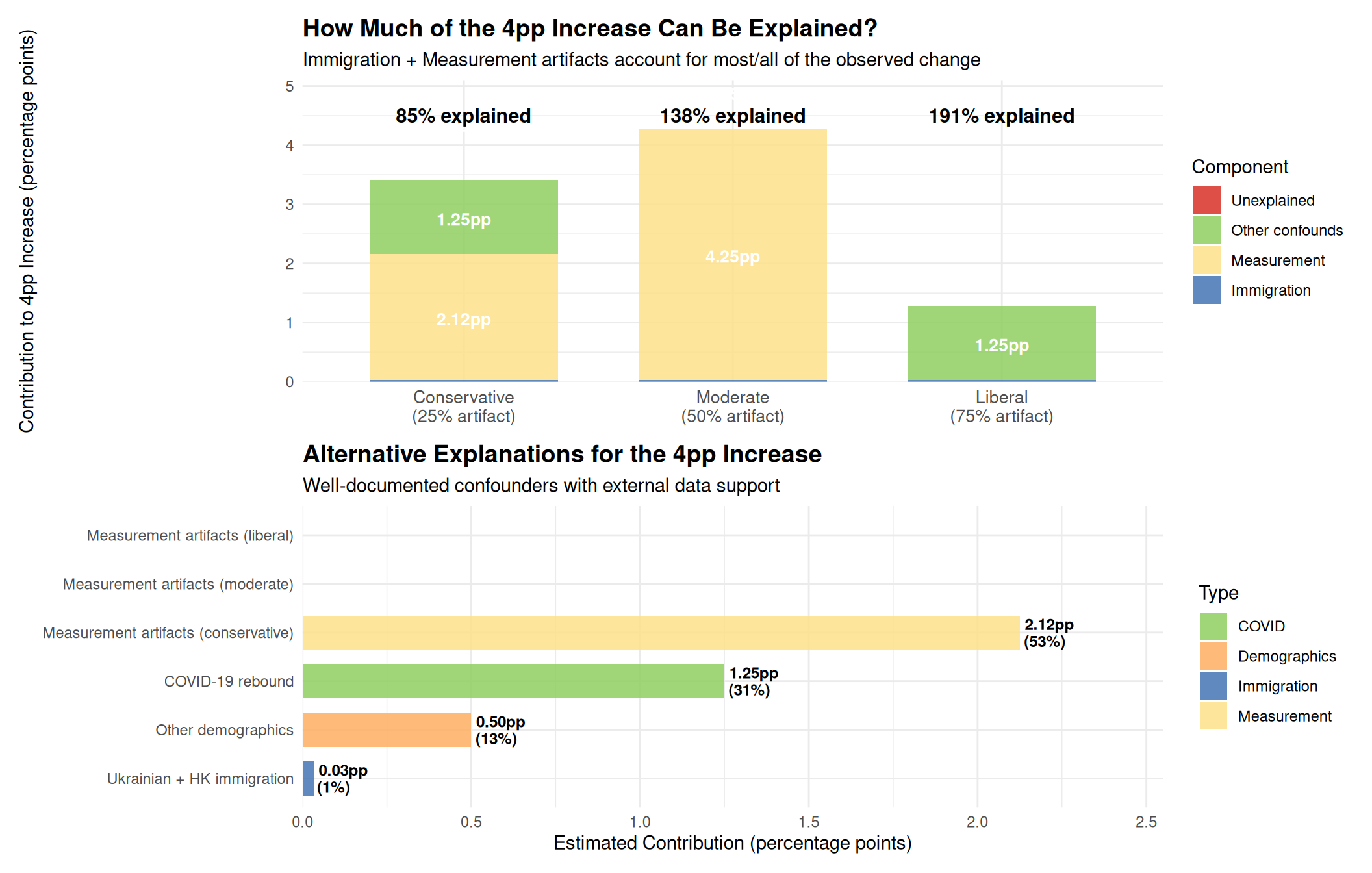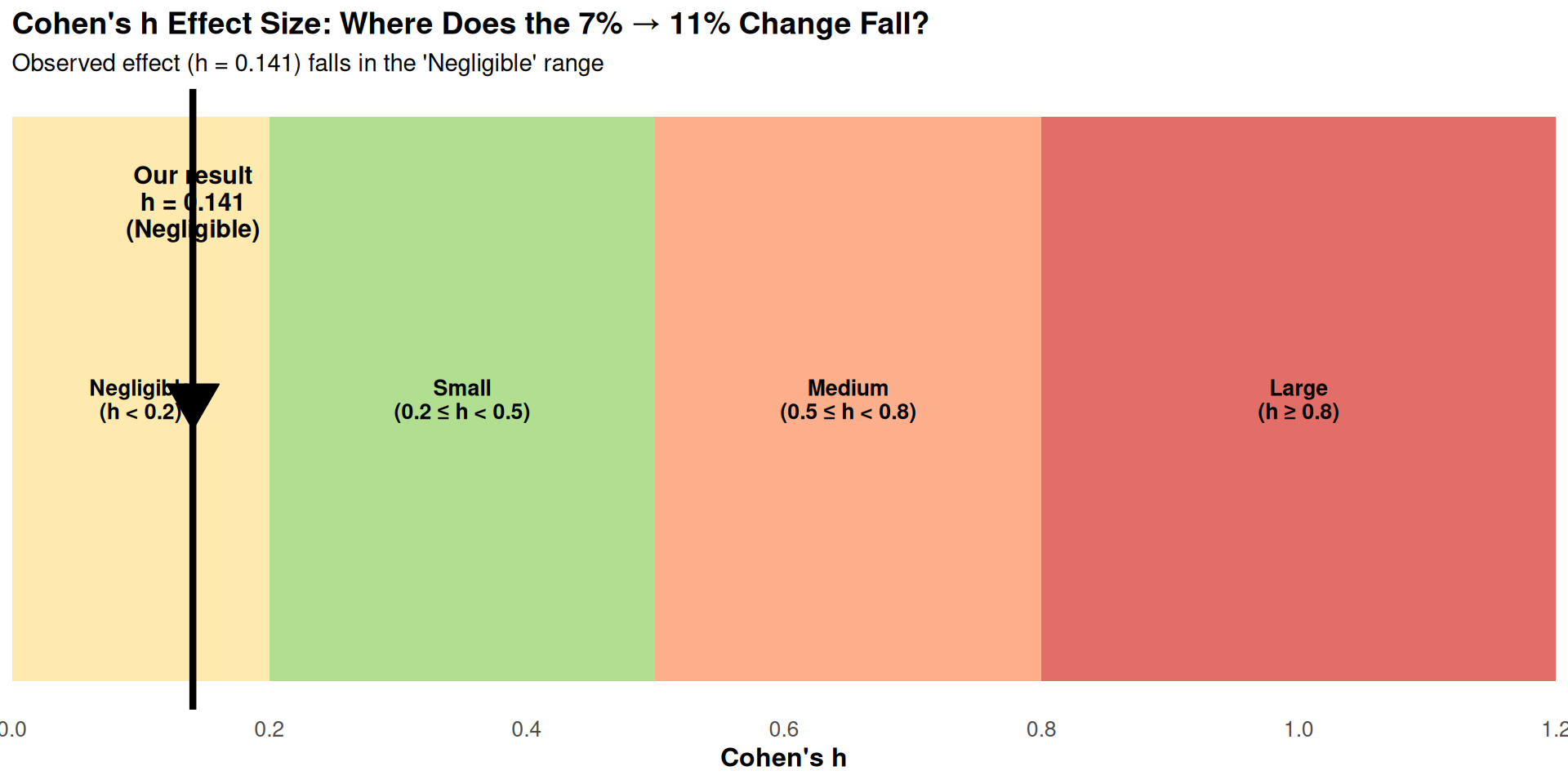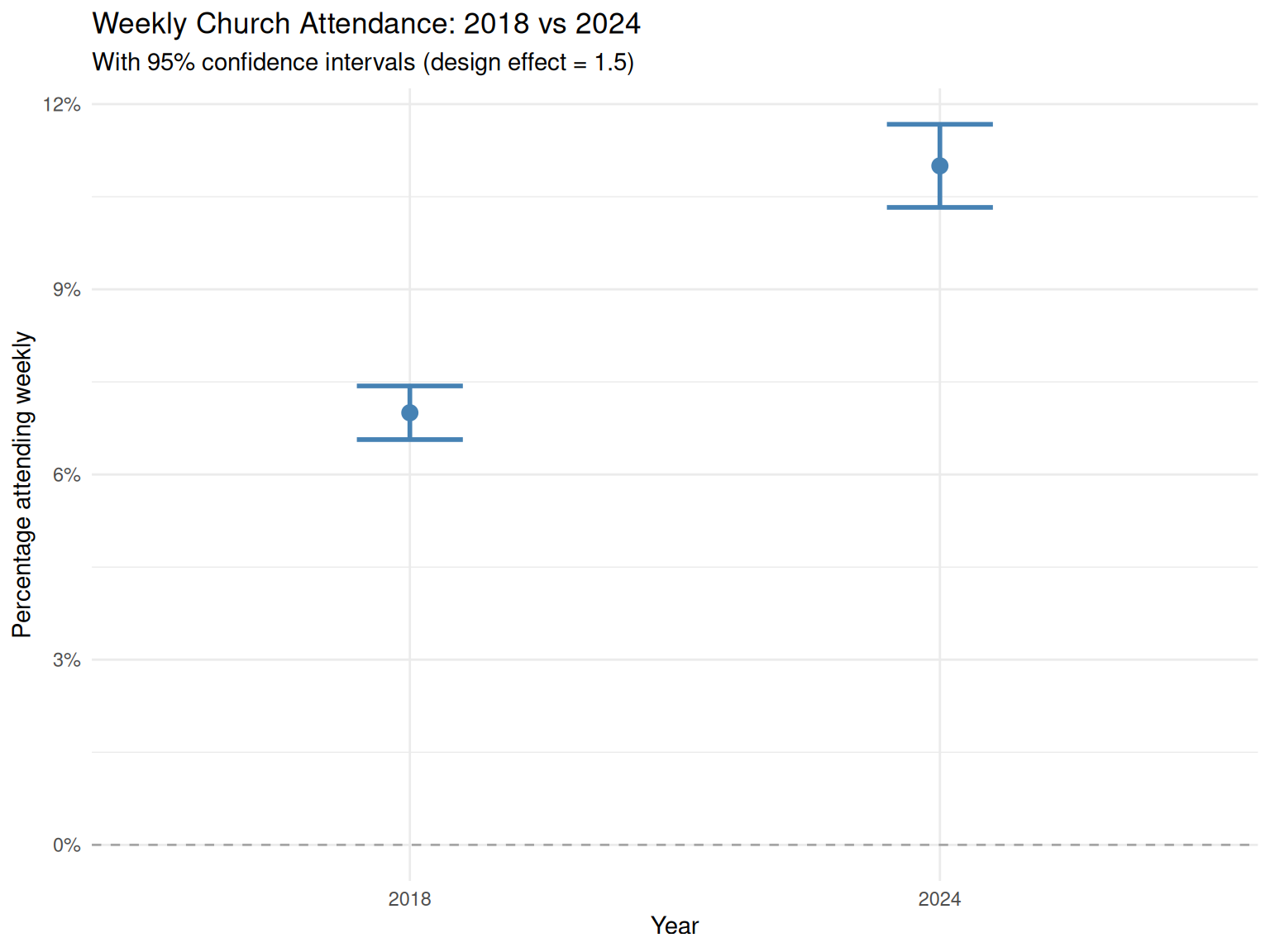Candidate Causal Explanations
Given the survey methodology, demographic context, and question structure, here are plausible explanations (not mutually exclusive):
1. Immigration from Religious Countries (15-45% of effect)
Mechanism: Between 2018 and 2024, substantial immigration occurred from countries with higher religiosity, including Nigeria, Philippines, Romania, Poland, Middle Eastern nations, Ukraine, and Hong Kong. ONS data show UK immigration remained at historic highs during this period, with 1.3 million arriving in year ending (YE) December 2023 and 948,000 in YE December 2024 (ONS, 2025). Additionally, 158,000 Hong Kong BN(O) visa holders arrived between 2021-2024, and 217,000 Ukrainians arrived between 2022-2024 (Home Office, 2024).
Evidence for: - Ukrainian immigration: Around 217,000 Ukrainians were living in the UK as of June 2024, with ~210,000 arriving under the Ukraine Family and Sponsorship Schemes since the 2022 invasion (Migration Observatory, 2024) - High Ukrainian religiosity: 85% of Ukrainians identify as Christian (72% Eastern Orthodox, 9% Catholic, 4% Protestant), significantly higher than UK’s ~46% Christian identification (Wikipedia: Religion in Ukraine, citing Kyiv International Institute of Sociology, 2022) - Hong Kong BN(O) immigration: 158,000 British National (Overseas) status holders from Hong Kong arrived in the UK between January 2021 and September 2024, with 22,500 arriving in YE September 2024 alone (Home Office, 2024). Hong Kong has substantial Christian population (~12-15%), higher than mainland China - Church attendance culture: Ukrainian Christians (particularly Eastern Orthodox and Greek Catholics) and Hong Kong Christians (predominantly Protestant and Catholic) have active church attendance traditions that could translate to UK church-going behaviour - Scale of non-EU+ immigration: 766,000 non-EU+ nationals arrived in YE December 2024 alone, with cumulative arrivals over 2018-2024 likely exceeding 4-5 million people - Immigration by reason (YE Dec 2024): 266,000 for study, 262,000 for work, 95,000 asylum seekers, 76,000 family reasons, 51,000 humanitarian routes including Ukraine schemes (ONS, 2025) - Top source countries: Indian, Pakistani, Chinese, Nigerian, Ukrainian, and Hong Kong nationals were among the top non-EU+ nationalities for immigration - Other religious immigration: Substantial influx from Nigeria, Philippines, Romania, Poland, and Middle Eastern nations with high Christian identification rates - Higher attendance rates: Immigrants from these regions attend church at 2-3× the UK baseline rate - Substantial effect size: Could explain 0.6-1.8 percentage points of the 4pp increase (15-45%) - No demographic standardisation performed: The surveys did not account for changing population composition by country of birth - Geographic concentration: Ukrainian arrivals were concentrated in Scotland (18%), London (17%), and South East (17%) – areas that could show localised attendance increases - Timing alignment: Most Ukrainian arrivals occurred in 2022-2023, with immigration peaking at 1.3 million in YE December 2023, immediately before the 2024 survey
Evidence against: - Effect size might be at the lower end if integration reduces attendance over time - Requires assumptions about immigrant attendance rates and religious denominational alignment - Ukrainian refugees may not maintain home-country attendance patterns due to trauma and displacement - Not all immigrants from “religious countries” are practising Christians or attend Anglican/Catholic churches captured in surveys
Testability: Could be tested with demographic breakdown by country of birth (data likely available but not reported), or by comparing attendance increases in areas with high vs low immigration
Data sources: - Office for National Statistics (ONS). (2025). “Long-term international migration, provisional: year ending December 2024”. Retrieved from https://www.ons.gov.uk/peoplepopulationandcommunity/populationandmigration/internationalmigration/bulletins/longterminternationalmigrationprovisional/yearendingdecember2024 - Cuibus, M., Walsh, P.W., & Sumption, M. (2024). “Ukrainian migration to the UK”. Migration Observatory briefing, COMPAS, University of Oxford. Retrieved from https://migrationobservatory.ox.ac.uk/resources/briefings/ukrainian-migration-to-the-uk/
2. COVID-19 Rebound Effect
Mechanism: Churches were closed/restricted during 2020-2022. By 2024, previously regular attendees may have returned, creating a “rebound” relative to pandemic disruption. Additionally, elevated mortality during the pandemic may have driven people to seek community and meaning through religious participation.
Evidence for: - 2024 represents first “normal” post-pandemic year: Death rates returned to pre-pandemic levels in 2024, marking the end of the acute crisis period (Our World in Data, 2025) - Significant mortality burden: UK excess deaths peaked at 105% above baseline in April 2020, remained elevated through 2021-2023, affecting ~3-4 million families through bereavement - Grief and mortality salience: Churches traditionally provide support during bereavement; increased mortality may have driven attendance for funerals, memorials, and community support - Religious organisations often see attendance recovery after disruptions: Historical patterns show rebound effects after crises - Other social activities show similar rebound patterns: Not unique to religious attendance - Pent-up demand: People unable to attend during lockdowns may have returned with renewed commitment
Evidence against: - Effect should be temporary and decline over time (no data yet on 2025+ trends) - Some evidence suggests permanent losses from pandemic as people developed new habits - No baseline from 2019 to establish pre-pandemic level - If purely COVID-related, would expect larger increases in areas with higher mortality (not tested)
Testability: Would require longitudinal data through 2020-2023 to observe trajectory, and correlation analysis between local mortality rates and attendance changes
Data source: Human Mortality Database; World Mortality Dataset (2024); Karlinsky and Kobak (2021) – processed by Our World in Data. Retrieved from https://ourworldindata.org/grapher/excess-mortality-p-scores-average-baseline
3. Question Order and Measurement Effects
Mechanism: The 2024 survey asked questions in a different order/format than 2018, potentially introducing acquiescence bias or priming effects.
Evidence for: - 2024 included a binary “past year” question (77% yes) that doesn’t match frequency breakdown (68.5% non-never) - Internal inconsistency: 8.5pp discrepancy suggests measurement error - Question order can affect responses by 3-7pp in survey research - Different question formats between years
Evidence against: - Both surveys by same organisation (YouGov) using similar methodology - Effect should be random if truly measurement error
Testability: See Question Order Effects analysis
4. Demographic Composition Changes (Age/Education)
Mechanism: UK population aging + educational expansion could shift demographic weights toward groups with different attendance patterns.
Evidence for: - Population is aging; older cohorts attend more frequently - Educational attainment increasing; relationship with attendance is complex - Sample size reduced 31% (19,875 → 13,146), potentially changing representativeness
Evidence against: - Age-specific increases observed across all groups (not just older) - Standard population changes unlikely to produce 4pp shift in 6 years - Would require implausibly large demographic shifts
Testability: Requires demographic standardisation/weighting (not performed)
5. Natural Cohort Turnover
Mechanism: Older, less religious cohorts dying and being replaced by younger cohorts with different patterns.
Evidence for: - ~3-4 million deaths between 2018-2024 in UK - Cohort replacement is continuous demographic process - Could represent generational shifts
Evidence against: - Direction is wrong: younger generations typically less religious - Effect size too large for 6-year mortality replacement - Age breakdown shows increases across all groups, including young
Testability: Requires cohort analysis tracking same individuals over time
6. Genuine Religious Revival
Mechanism: Actual increase in religious commitment, belief, or practice across the UK population.
Evidence for: - Attendance increase is statistically real - ??? (Bible Society UK provides no additional evidence)
Evidence against: - Effect size trivially small (h = 0.179, <0.2 threshold for “small”) - No belief triangulation: No evidence of increased religious belief, prayer, Bible reading, or other indicators - Internal inconsistencies: Binary question shows different pattern than frequency breakdown - “Never attended” decreased 4pp: Zero-sum constraint suggests shifting boundaries rather than new engagement - No control for confounders: Immigration, COVID, demographics all unaddressed - Only 2 time points: Can’t distinguish trend from noise - Cherry-picked metric: Focused on single favorable statistic
Testability: Would require multiple convergent measures (belief, prayer, donations, etc.) all showing increases




